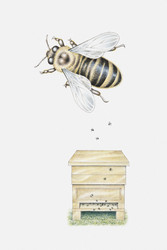Bee movements control reproduction
Honeybees are under threat globally from the epidemic known as colony collapse disorder, caused by a number of pathogens, insecticides and other, unknown factors. Understanding how bees in a hive interact with one another can help scientists understand communication and disease transmission. The EU-funded BEESPATNET (Mapping spatial interaction networks in honeybee colonies) project aimed to track the movements of individual bees within the hive, focusing in particular on the movements of the queen bee. BEESPATNET modified a tagging system used to track ants for use with bees. This involved attaching an electronic tag to the body of 1 000 newly hatched bees as well as the queen, and tracking those bees for 31 days. This period is the lifespan of an average worker bee. The project recorded daily movements of each bee, as well as interactions between bees. From this data they created individual trajectories as well as contact networks, where nodes represented two bees meeting. The project found that the queen's movements (within a limited area of the nest) maximise the spread of queen mandibular pheromone (QMP). This is the signal by which the queen prevents workers from laying eggs and inhibits them from raising a new queen. Researchers also investigated how worker movement spreads QMP throughout the hive. This knowledge will help the bee industry better control when hives will create new queens and split into two colonies.
Keywords
Honeybees, disease transmission, spatial interaction networks, honeybee colonies, queen mandibular pheromone

